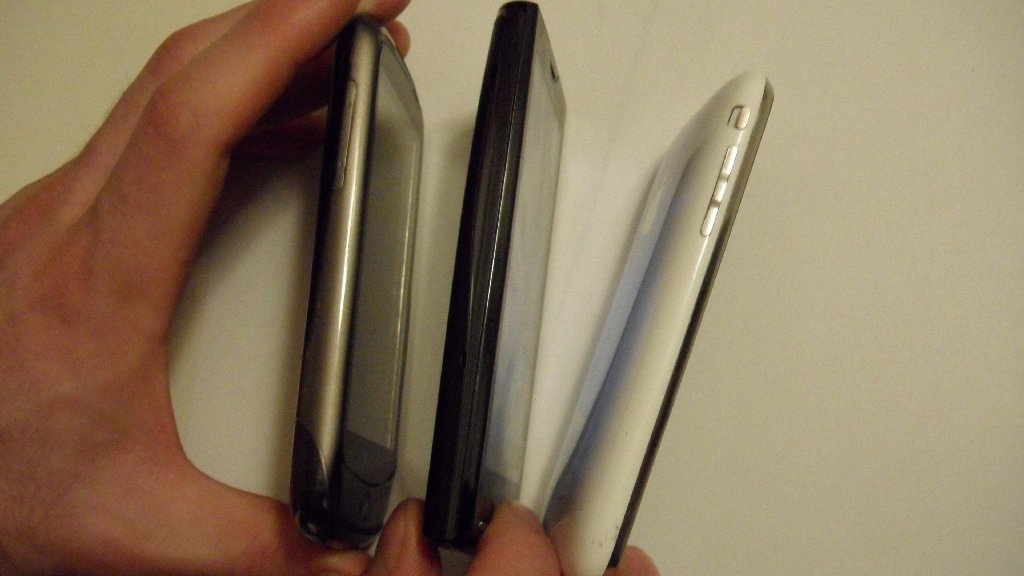ARTICLES:
Sony Ericsson Xperia X10 Video Review: Much Of The Same, A Little Bit Worse
Update: Here is a video overview we put together to go with the review. Sorry for the bad perspective!
There was a lot of anticipation in the run-up to the release of the Sony Ericsson Xperia X10. It was SE’s first Android handset. On paper, its specs were amazing (and still are): 4-inch 854x480px screen, 1GHZ Snapdragon processor, 512MB RAM, 8MP camera with light. Its custom skin was not to be as overpowering as HTC’s Sense UI or Motorola’s MOTOBLUR. Its Timescape and Mediascape applications were just overlays on top of the standard Android 1.6 OS. Timescape was supposed to give you a beautiful 3D layout of all your social media platforms. Mediascape was supposed to be your music- and video-viewing one-stop-shop.
Supposed to, supposed to.
So much potential. Where did it go wrong?
Well, nowhere, exactly. The phone performs largely as it sets out to: as a high-end Android device. But somewhere along the line, Sony Ericsson made mistakes. They released buggy software on a relatively stable OS, resulting in hit-and-miss performance.
Software
Let’s start with the most glaring example of where they went wrong: the software keyboard. To the naked eye, the Xperia keyboard looks relatively similar to the stock Android keyboard. Most of the keys are in the same place, and it has the nice auto-correct system that you are used to if you’ve used other Android devices. But this keyboard is stupid. It does not correct intelligently. In fact, the word it suggests to you is usually the wrong word, but your correct word is often sitting to the left or right of the one that, if you let go of the space bar, it will automatically change the word to. It is infuriating.
To top it off, to say the keyboard is inconsistent would be a misnomer. It is not merely inaccurate and difficult to use; it is diabolical. Letters seem to appear out of nowhere, and selections seem random, even meant to throw you off. I do not suggest using the stock Xperia keyboard. I suggest going to XDA-Developers and downloading a modified version of the HTC Sense keyboard. It is by far the best virtual keyboard available to date. Give it a try.
Luckily in Android, unlike on the iPhone OS, it is easy to change your keyboard. You merely have to download a new keyboard, install it, and go to the Settings -> Language/Keyboard menu to enable to one you just downloaded. Next, in a text box on any screen, hold down your finger until the popup with “Input Method” emerges. Merely select your keyboard from the radio list and voila. You’re done!
Hardware
Now, to go back to the Xperia X10. There is something wrong with the screen. It is gorgeous. By far and away the most vivid, accurate, high-resolution screen I’ve seen on a mobile device. It is better even than the Droid screen, which is the same resolution. Colours pop motion is fluid, and you would have to struggle to see individual pixels. In short, it is what makes the phone worth using. But there is only one problem. The screen is muddy; it often doesn’t register finger inputs. Using the same keyboard on the X10 and the Nexus One, I found I had to press down almost twice as hard on the former device to get the same key to register. Sometimes my finger would press one key and it would select another one entirely.
When you’re dealing with a device that does not have a dedicated hardware keyboard, to have an inaccurate screen is a death knell.
Design-wise the device is great. It’s sleek and well-proportioned. It does not feel too heavy, and the curved back gives it an elite feel that would go over well with any iPhone 3GS or BlackBerry 9700 user. The front of the device is taken up almost exclusively by the screen, which, again, is freaking stunning. Below the screen are three hardware buttons: Select, Home, Back. These are in unusual places compared to other Android devices, where the back button is usually on the left of the screen. Takes some getting used to. On the left side is nothing but a microphone, and on the right are the volume rocker and below that the dedicated camera key, which often comes in handy.
The top of the device houses the power button and an infuriating cover for the Micro-USB port. I hate devices with these covers, though I realize they are more aesthetically pleasing, and safer, than a gaping hole somewhere on your device. That being said, KILL THE PORT COVERS. They are way more hassle than they’re worth.
The back of the device is one of the nicest in recent memory. It is completely smooth but for the small camera lens and flash, and a very sexy Sony Ericsson logo.
The camera on the device is excellent. At 8.1MP, it had better be. The pictures are quick to take and re-take, and I think it’s one of the better phone cameras on the market. That being said, there is one major issue: the flash is not really a flash, but a camera light. That means that, for the entire time you are in the photo app, the camera light is on. To turn it off is a cumbersome set of steps that involves opening the advanced settings menu in the camera app and turning off the camera light. I wish they the company had thought it through and realized it would be much more battery-friendly if the phone had a light sensor to detect whether the flash should be on or off. The Nexus One does this extremely well, and it is something you shouldn’t have to think about. It should just work.
Android Implementation
As an Android phone, there really isn’t much to say. It has a nice blue-tinged theme that pervades the standard menus, and because it is on Android 1.6, most current apps do run on the device. SE has come out and said that, even if the phone is upgraded to 2.1 in the fall, it will not have multitouch enabled on the device; it is hardware, not software, limited. This is extremely disappointing, and goes to show how little forethought the company made into the design of the device. Did they not think that, down the road, consumers would be used to having multitouch on their iPhones and Droids and Nexus Ones and expect this from a high-end device such as the Xperia X10? Perhaps in trying to keep costs down they chose to go with a higher-quality LCD screen without multitouch rather than skimping on the screen quality. Who knows? Either way, though, the Droid/Milestone is proof that you can have your high-res cake and eat its multitouch too.
Android 1.6, besides the lack of multitouch, does have some other limitations. Certain apps will not run on the device due to the lack of APIs available to the OS from Google. Features like Voice-to-Text, Live Wallpapers, enhanced media capabilities. Overall, though, your experience with Android 1.6 won’t be too dissimilar to that of Android 2.0 or 2.1, which is the latest version available. Most of the upgrades in 2.1 are speed-related, and that is obvious when using the Xperia X10 next to the Nexus One.
Despite the fact that the devices use the same processor and same amount of RAM, the Nexus One screams, whereas the X10 just flies. There is obvious stuttering and slowdown in many apps that don’t the N1 is not bothered by. That isn’t to say the X10 is slow. It isn’t. It just doesn’t live up to its potential.
Another glaring omission on the X10, though its omission shouldn’t be missed, is that of a directional pad or trackpad. All HTC Android devices come with one, and the Droid has its famous four-way directional pad. Why is this important, though so seldom used? Because unlike the iPhone OS, Android’s text selection implementation is non-existent. If you type something and need to go back and edit what you wrote, you may have to jab your finger in the general direction of the text before you land on it, only to graze your finger over the screen and lose your place again. It’s frustrating, to say the least. Though it was likely a design decision not to include it, the X10 loses productivity points for that alone.
X10-Specific Features
Another feature exclusive to the X10 are Timescape and Mediascape, either in widget formats or as apps themselves. Timescape consolidates your media updates, such as Twitter, Facebook, SMS, Email, into a series of 3D cards you can scroll through. Clicking on one will take you into another app, so its usefulness is severely minimized. And once you have hundreds or thousands of updates in the program, it slows to a crawl. It’s more a technology demo than a usable piece of software; you will garner some oohs and ahhs from friends admiring the beautiful 3D effects, but beyond that, I’d leave it alone.
Mediascape is more usable, though nothing extraordinary. It consolidates your music, movies and photos into a single app with an attractive UI. Nothing more.
Battery Life
To add further insult to injury is battery life. The phone barely gets more than 6 hours of minimal use from a full charge, and less than 3 with heavy use. My tests involved keeping WiFi, GPS and Bluetooth off, and using it as I would throughout the day. Unfortunately, though, I noticed that the battery just dropped like a stone, losing 10-15% an hour.
Phone use was even worse: I came off a 20-minute phone call to find the battery had dropped by nearly half. This is unacceptable, and hopefully something SE can fix when they release their Android 2.1 system update in Q4.
Conclusion
See the movie below (it’s coming), as I’ve exhausted my time and space writing this eulogy to a great phone turned bad. I won’t be surprised if this is one of Rogers’ best-selling devices, as to the non-critical eye looking for an attractive smartphone with tons of features that’s cheaper than an iPhone and has some buzzwords its competitor doesn’t (multitasking! high-res screen! multitasking!!) it’s hard to beat.
I’d recommend holding off on the phone until either a software update fixes some of the bugs, or for the next generation, which SE is no doubt working on as we speak.
For the tech geek: 6/10
For everyone else: 8/10
-
Crash27
-
Crash27
-
Crash27










